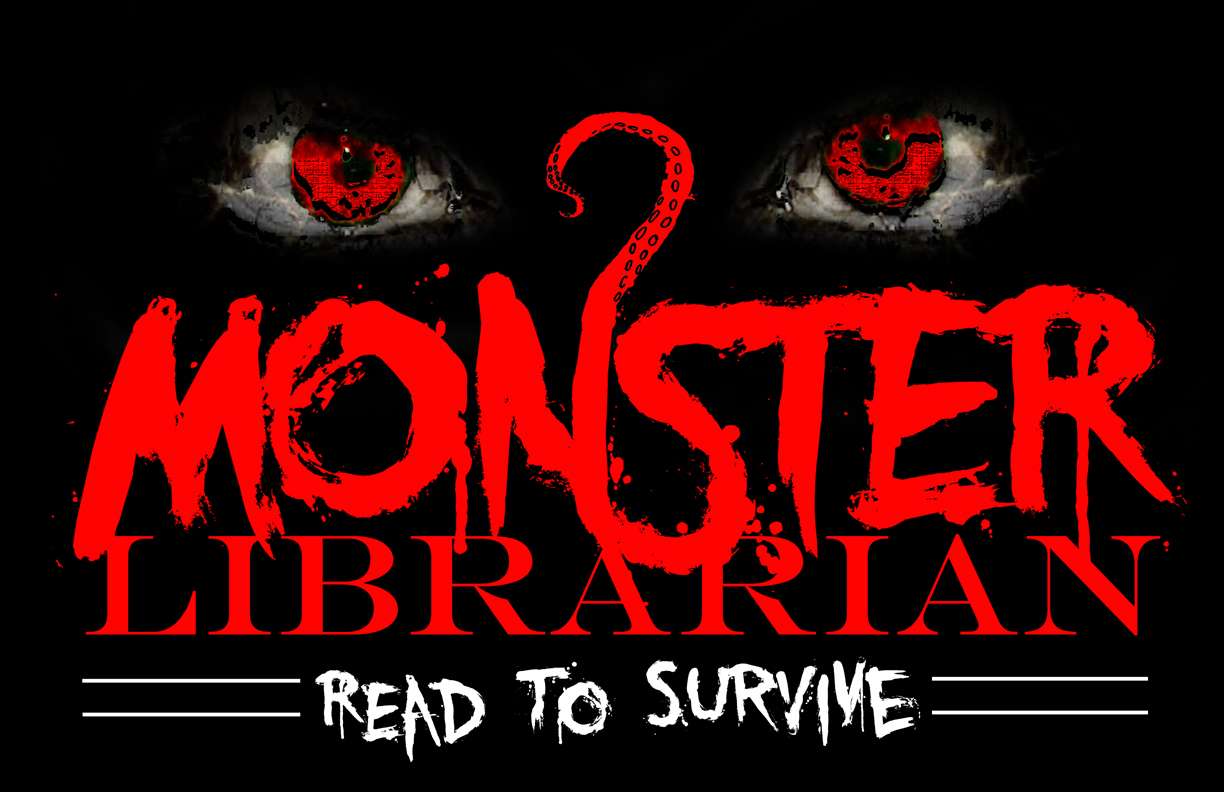 |
||
| Monster Movie Month | ||
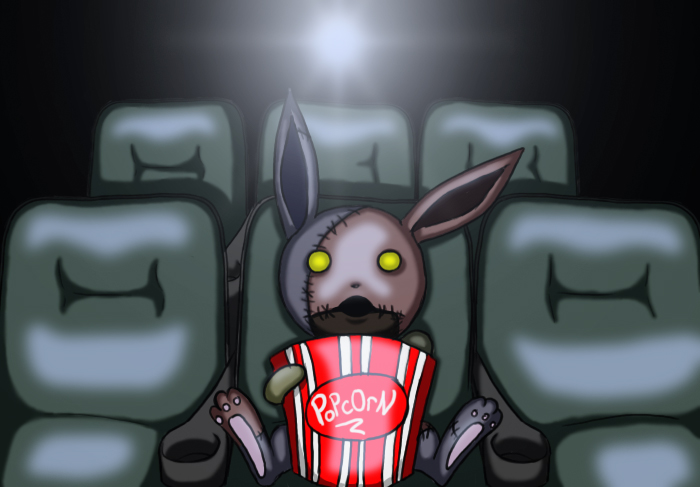
Horatio at the Movies by Darleen Wanglund
| Introduction | Vampires | Zombies |
| Lovecraftian Horror Movies | Werewolves | Scary Movies for Children |
| Godzilla, Kaiju and Giant Monster Movies | Killer Animals | Our Pinterest Board |
The horror genre is pervasive through out popular culture, it can be found in movies, books, TV shows, graphic novels, and video games. This July MonsterLibrarian.com will be making a connection between horror movies and books. We hope to help horror movie lovers find a good book to read and horror readers find a frightening flick to watch on a dark and stormy night.
We will be updating both this page and our Musings of the Monster Librarian blog with original Monster Movie Month content through out the month so visit often.
Current posts: At the Movies with Ray Harryhausen
Not So Scary Movies (and TV) for Kids
Frankenstein and Other Mad Scientists
Wendy Zazo-Phillips reviews The Cutting Room podcast and interviews the hosts here
To start the fun we have the Shocklines Horror Movie Survival Guide which is sure to put a smile on any monster movie fan's face.
Howard Philips Lovecraft, known as H.P. Lovecraft, was a writer of weird fiction- tales with a supernatural bent- and a defining influence on the horror genre. He was born on August 20, 1890, and died at age 46 on March 15, 1937.
Lovecraft is best known for his invention of the Cthulu mythos- a cycle of loosely-related stories that concerned the "Great Old Ones," beings from outer space who took up residence on Earth to cause total destruction. After Lovecraft's death other authors, including August Derleth and Robert E. Howard, took up writing stories using the Cthulu mythos, and writers continue to use and find inspiration in his ideas and mythos today . The subgenre of Lovecraftian horror uses the concept of cosmicism. According to Wikipedia, that can be defined as "the sense that ordinary life is a thin shell over a reality which is so alien and abstract in comparison that merely contemplating it would damage the sanity of the ordinary person".
Blog post: At the Movies with H.P. Lovecraft
Lovecraft Resources
Click below to see a review, suggested read-alikes, and a one-sheet handout for the newest Lovecraft-inspired movie, Cabin in The Woods, from reviewer Benjamin Franz.
Want to build your library's collection of Lovecraft's works and Lovecraftian fiction? We have resources for you!
Visit Jamie Blackman's H.P Lovecraft Collection Development Guide, presented by MonsterLibrarian.com
Check out Monster Librarian's reviews of other works inspired by Lovecraft's writing- visit our Cthulhu Mythos page.
Benjamin Franz has put together an excellent one sheet reader's advisory handout for the The Cabin in the Woods.
Movie Review: The Cabin in the Woods
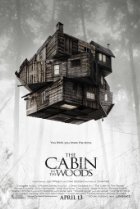
The Cabin in The Woods by Drew Goddard and Joss Whedon, Directed by Drew Goddard
2012, Lionsgate Pictures
Available: Still in Theaters!
This fall on blu-ray, dvd, kindle, Netflix.
The Cabin in the Woods is a stand-alone movie by Drew Goddard and Joss Whedon. It was made back in 2009, and was stalled until this year, because the studio was not certain how people would take to the film. I’m here to tell you that this is one heck of a good movie. If you haven’t seen it yet, you must.
The Cabin in the Woods takes the age old story of young people spending a weekend in a cabin in the – you guessed it – woods and turns in on its ear. These young people are all great students, yet you wouldn’t know that watching them hang in this cabin. This is but one of the deep rich mysteries in this film.
By the end, the writers have blended the students, with these two office drones we see at the beginning of the film, and a whole lot more stuff I shall NOT spoil, constant reader, and make an incredibly violent, funny and dark film that you never saw coming. This is HIGHLY recommended for all but the most squeamish of movie goers.
Read-Alikes
Books: At the Mountains of Madness by H.P. Lovecraft; Necronomicon by Alan Moore; The Old One by Todd Brabander
Films: In the Mouth of Madness (1994); Cabin Fever (2002); The Call of Cthulu (2005)
Contains: Violence, profanity, adult situations.
Reviewed by: Ben Franz
Lovecraftian movies (click on the cover art for synopsis and reviews at Amazon):








Godzilla, Kaiju and Giant Monster Movies
One of the most popular monster movies of all times is Godzilla, originally a creature spawn of nuclear radiation Godzilla has been stomping through Tokyo for over half a century playing both unstoppable force of destruction and defender of humanity from various space creatures. Godzilla is part of Kaiju, a Japanese genre of giant monster movies that have inspired graphic novels, books, games, and toys. There is also giant monster movies from the U.S., U.K., and Europe ranging from giant ants (Them), a praying mantis (The Deadly Mantis), and various dinosaurs (The Giant Behemoth and The Beast from 20,000 Fathoms) to name a few.
Movie Review: Gojira
Directed by Ishiro Honda
The first of many kaiju films to be released in Japan, Gojira was released by the now-famous Toho Studios. In 1956, the film was released in the United States under the title Godzilla: King of All Monsters, containing scenes of Raymond Burr spliced into Toho’s original film.
After two Japanese fishing boats are destroyed by a mysterious flash of light, reporters head to nearby Odo Island, where the natives tell of a mythological sea-god called Godzilla. Archaeologist Dr. Kyohei Yamane (Takashi Shimura) arrives on the island and it is soon attacked by a giant reptilian monster. After witnessing Godzilla’s attack, Dr. Yamane determines that the monster is the product of a nuclear explosion.
Godzilla makes his way into Tokyo Bay, where he comes ashore and destroys the city. Daisuke Serizawa (Akihiko Hirata), a colleague of Dr. Yamane and engaged to Yamane’s daughter Emiko (Momoko Kochi) has developed a top secret weapon that may be useful against the monster. Serizawa does not want to use his weapon because of the damage it could do to society, but is convinced by Emiko and Hideto Ogata (Akira Takarada) a local fisherman. Serizawa and Ogata dive to where Godzilla is at rest in the Bay. This is their chance to destroy the monster….but can they do it?
One thing that is glaringly apparent in Gojira is the anti-war/anti-nuclear message. This film was made by the only country to have a nuclear weapon detonated on its soil. One can guess that the monster Godzilla itself is either a product of America’s bombs or that Godzilla represents America itself. Either way, the anti-war message is clear. Toho’s film revolutionized SFX in movies, especially in the area of miniatures, thanks to Eiji Tsuburaya and his crew. They painstakingly recreated the city of Tokyo, in all of its detail, only to be destroyed by an actor in a rubber suit. It made for a breathtaking science fiction movie that has been seen by generations of fans. Gojira must be seen in its original 1954 incarnation, although the 1956 American version isn’t too bad to sit through.
NOTE* Gojira spawned not only numerous sequels and remakes, but an entire line of comic book titles.
Reviewed by: Colleen Wanglund
Book Review:
Godzilla on My Mind: Fifty Years of the King of Monsters
by
William Tsutsui
Palgrave Macmillan; First Edition edition (September 23,
2004)
ISBN-13: 978-1403964748
Available: New and Used
I'll admit it; I am not a huge fan of giant monster movies. But when my husband, a Godzilla fan from way back, started sharing the movies and his treasured action figures with our kids, I knew I would be going along for the ride. My own Monster Kid started grilling me on details of the movies, drawing pictures, telling stories, and making lists, and then he wanted to know which movie was my favorite.
I don't know where exactly he found it, but I noticed one day that he was carrying around a book that was pretty hefty for a six year old boy. He studied it carefully, and asked questions, and asked me to read parts to him. That was my first experience with Godzilla On My Mind. Once I started reading bits and pieces, I was intrigued enough to read it cover to cover on my own.
Godzilla On My Mind is an interesting book because the author is an academic who studies pop culture, and he's also an enthusiastic Godzilla fan. He's able to step back and examine the Godzilla phenomenon and the evolution of the monster and his associated movies (including American knockoffs) without coming off as pretentious- his anecdotes, such as the one about his Godzilla Halloween costume (complete with photograph)- show that he truly loves Godzilla. Some Godzilla fans have criticized the author for taking a critical approach to the movies, but that's balanced out by his obvious affection for the monster. His conversational style makes the text much more accessible to the reader.
For someone like me, who doesn't know very much about Godzilla except for general mainstream opinion, Tsutsui's approach worked well. I learned a little about what it's like to grow up loving Godzilla, and gained knowledge of many of the movies(and respect for a few). I learned enough to be able to answer a lot of my son's questions and was intrigued enough by what Tsutsui wrote about the original movie, Gojira, that I sought it out and watched it with my family, subtitles and all.
Tsutsui does a great job showing how this Japanese movie monster has become an integral part of American culture, language, and cinema history Whether you are a Godzilla fan or not, Godzilla On My Mind is an enjoyable and engaging read, and definitely worth your time. Highly recommended.
Reviewed by: Kirsten Kowalewski
List of Godzilla films click here
Books:
Crustaceans by William Meikle (reviewed here)
Unearthed by Gina Ranalli (reviewed here)
Raiju: A Kaiju Hunter Novel by K.H. Koehler (Young Adult) (reviewed here)
Addional giant monster books:
The Trench by Steve Alten
Meg: Primal Waters by Steve Alten
Meg by Steve Alten
The Loch by Steve Alten
Monster: Tale of the Loch Ness by Jeffery Konvitz
Crabs on the Rampage by Guy N Smith
Killer Crabs by Guy N Smith
Crab's Moons by Guy N Smith
Mandibles by Jeff Strand
Crabs: The Human Sacrifice by Guy N Smith
The Dragon by William Schoell
Saurian by William Schoell
Extinct by Charles Wilson
The vampire, blood-drinking creature of the night, is an iconic monster who has appeared in many incarnations (both monstrous and romantic) in both fiction and the movies. The vampire Dracula, created by Bram Stoker for the novel of the same name, has inspired generations of filmmakers and authors. Look below for reviews of some classic (and maybe a few not-so-classic) vampire movies and suggested resources for both movies and books, and check out Musings of the Monster Librarian's guest post from Krista Cox on the Francis Ford Coppola film Bram Stoker's Dracula.
Guest post: The Blood is the Life by Krista Cox
Directed by F.W. Murnau
This is THE vampire film. Sure, you thought it was Dracula, but Nosferatu (a thinly-veiled Dracula) is a miracle of modern film. First, it was the only film produced by Prana Film. It used storytelling and camera skills that were cutting edge for the day, and remains one of the best films of the world to this day. Despite being a silent film, the mood captures audiences in ways modern effects struggle with. A lawsuit by the Stoker family saw the company bankrupt and all copies of the film save one destroyed, so it's amazing that it's easy to find today in DVD collections of horror flicks. Every monster movie and horror film fan should see this movie at some point, not just to see how the genre began, but what it can be when the plot is about more than blood-soaked t&a.
Reviewed by: Michele Lee
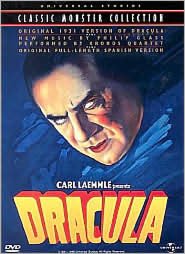 Dracula
(1931)
Dracula
(1931)
Directed by Todd Browning
Released in 1931 by Universal Studios, Dracula was based on a stage play written by Hamilton Deane and John L. Balderston which was only loosely based on the original novel by Bram Stoker.
Renfield (Dwight Frye) has gone to see Count Dracula (Bela Lugosi) about his renting of Carfax Abbey in London. While at Castle Dracula, Renfield is attacked and is now a raving lunatic and sent to Dr. Seward’s (Herbert Bunston) hospital after the ship carrying Renfield and the Count’s things arrive in England. Some days later Count Dracula meets Dr. Seward, along with the doctor’s daughter Mina (Helen Chandler), her fiancé John Harker (David Manners) and family friend Lucy Weston (Frances Dade). Later that night, Lucy is visited by the Count, and dies the next day due to severe blood loss.
Professor Van Helsing (Edward Van Sloan) is called in to investigate the mysterious circumstances and determines that Dracula is a vampire. After speaking with Mina, Van Helsing realizes that she is the Count’s next victim. Dracula speaks to Van Helsing and informs him that Mina has been bitten and belongs to the Count. It is now a race against time to save Mina and destroy the vampire.
Dracula is a classic horror film. While a lot of the story differs greatly from Stoker’s novel, it still contains the principal players and the core of the novel. Van Helsing is pitted against the vampire Dracula, a supernatural creature that cannot be destroyed as easily as a regular man. Dracula was the first of what eventually became known as Universal’s Monsters and although it doesn’t hold the same scary impact that it did in the 1930’s, it still holds up as a classic favorite among most horror fans. Bela Lugosi’s portrayal of the blood-sucking Count is nothing short of legendary. It has been imitated and at times mocked, but Lugosi’s Dracula is iconic. The atmosphere is dark and foreboding and still disturbing in relation to the main character’s comparisons to rape and heroin use. Dracula is a must-see horror staple.
Reviewed by: Colleen Wanglund
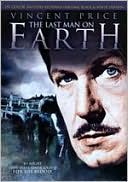 The Last
Man on Earth
(1964)
The Last
Man on Earth
(1964)
Directed by Ubaldo Ragona and Sidney Salkow
Based on the novel I Am Legend by Richard Matheson, the film focuses on Dr. Robert Morgan (Vincent Price) and his battle to survive in a world where he seems to be the last man left alive. It seems as though every human being has been infected with a plague that causes the victims to become undead, vampire-like creatures. Every night Morgan barricades himself inside his home while the creatures gather outside in the hopes of feeding on him. Every day Morgan takes his weapons and goes on the hunt for the vampires, who must hide from the sun.
Through flashback sequences we learn that Morgan’s wife and daughter both fall victim to the plague and his wife returned for him. Now, Morgan is a mess, struggling with not just his physical fight for survival, but his psychological struggle, as well. Morgan has also been trying to find a cause and perhaps a cure.
One day while out scouting, Morgan comes across another survivor. Morgan is suspicious of Ruth, but brings her back to his home anyway. Ruth’s true nature is exposed and she explains to Morgan that not all plague survivors are mindless vampires. Her people know about Morgan and are planning to come after him for the murders he committed over the last three years. She wants to help him, but doesn’t know if she can.
The Last Man on Earth is only the first adaptation of Matheson’s 1954 novel, and follows the book more closely than say The Omega Man (1971), which is a great movie in its own right. Vincent Price captures the character of Morgan wonderfully, getting across the psychological toll Morgan’s predicament causes. We see the apprehension yet hopefulness upon finding Ruth. The end of the movie has been slightly altered from the book, but it is no less powerful in its devastating implications. The Last Man on Earth is a classic of the horror genre and is wholly worth watching.
Reviewed by: Colleen Wanglund
Are you intrigued enough to try out additional interpretations of Dracula? Here's a good Dracula filmography from PBS' Masterpiece Theatre.
Want to try a book instead? Check out our reviews of adult vampire fiction here, and our reviews of young adult vampire fiction here (including Kate Cary's excellent novel Bloodline, loosely based on Dracula). We have some graphic novel adaptations of Dracula on our young adult graphic novels page, and if that doesn't satisfy your appetite, you can visit our YA vampire fiction blog Reading Bites. Be warned, though, when making recommendations, that Dracula doesn't sparkle. Stoker's novel, and its children, have sharp teeth.
Other vampire movies (click on the cover art for synopsis and reviews at Amazon):








or try these vampire books:







While werewolves, lycanthropes, and shapeshifters appear across the folklore and mythologies of many civilizations, the werewolf is one of the few iconic monsters that has no clear literary roots. In his guest post at Musings of the Monster Librarian, Gregory Lamberson, a horror fiction author currently writing a werewolf series, writes of his surprise when he discovered that the source of most modern werewolf lore was created by Curt Siodmak for the Universal monster movie The Wolf Man. That one movie inspired generations of filmmakers and writers is a testament to the power of movies to inspire the imagination. Below you'll find a review of one of the classics of the genre, An American Werewolf in London, as well as a few other interesting titles (including Blood & Chocolate, based on the YA novel by Annette Curtis Klause) and of Gregory Lamberson's most recent werewolf novel, The Frenzy War.
In the past, July has been Werewolf Month at MonsterLibrarian.com, so if you're interested in discovering werewolf fiction of all kinds, visit our Werewolves page, which also includes artwork, short stories, and
interviews. Just scroll down the page and you'll find plenty of great material.
Gregory Lamberson's guest post, "Werewolves, Lycans, and Shapeshifters, Oh My!" has a lot of great information movies in this genre. If you'd like to learn a little more about some of the movies mentioned, you can check out Werewolf-Movies.com, a database of information about werewolf movies. It's no longer being updated, but it's still a great resource! The site also has an article listing the "The Wolfman Returneth: Essential Werewolf Movies". It is one person's opinion, of course, but if you're trying to narrow the choices down, you might want to take a look. We'll also provide links to some of the movies below.
Enjoy!
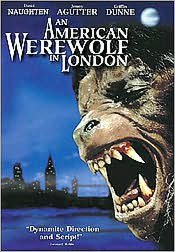 An
American Werewolf in London
(1981)
An
American Werewolf in London
(1981)
Directed by John Landis
Two young Americans are backpacking through the United Kingdom when they are attacked by a werewolf while out on the Scottish Moors. Jack (Griffin Dunne) is killed and David (David Naughton) is badly injured. Three weeks later, David awakens and is told that his friend Jack is dead and the two men were attacked by an escaped lunatic. David is eventually “visited” by Jack’s corpse, who tells him they were in fact attacked by a werewolf and that David is now one himself.
Upon David’s release from the hospital, he moves into the apartment of the young nurse Alex (Jenny Agutter) who cared for him, and of course a relationship develops. The inevitable happens when on the full moon David changes into a werewolf. David realized what he has done and now not only is Jack visiting David, but so are David’s victims. Jack has been urging David to kill himself so that he doesn’t hurt or kill anyone else. David turns once again, leading to the film’s fairly predictable conclusion.
Landis’ film is dark but at times funny. Griffin Dunne is brilliant as Jack and David Naughton presents a sympathetic David. While the film is a classic in the horror genre, what really sets it apart are the Special Effects. David’s on-screen transformation was ground-breaking in its painstaking detail and captures the pain that transformation caused. In this age of CGI no one has even come close to London’s werewolf change. And Jack’s continuing deterioration as the movie progresses is beautiful to behold. While the relationship with Nurse Alex is fairly cliché and the ending a rather predictable one, I love the idea of Jack’s continued appearances and David being haunted by his victims….which does help drive the film to its conclusion. An American Werewolf in London is truly a gem of a horror movie.
For some excellent werewolf literature to follow up the movie, check out some of these books: Cycle of the Werewolf by Stephen King, The Howling by Gary Brandner, Snarl by Lorne Dixon, The Frenzy Way by Greg Lamberson, A Pack of Wolves by Eric S. Brown, and The Strange Case of Jekyll and Hyde by Robert Louis Stevenson
Reviewed by: Colleen Wanglund
Blood & Chocolate (2007)
Directed by Katja von Garnier
In the werewolf genre a lot of movies stick out (mostly for being terrible). An overlooked film is Blood & Chocolate. Loosely based on the novel of the same name by Annette Curtis Klause, Blood & Chocolate's strength is in its otherness, although that might also be the film's flaw. The story is set in Romania, and centers on creatures that look human, but very much aren't. Unlike other movies which initiate the audience by having a normal human pulled into supernatural circumstances, Blood & Chocolate is told through the eyes of a young woman who is on the verge of a great choice, one she didn't know she had. The movie failed to reach its audience in theaters, but the story connects with those on the edge between childhood and adulthood, who are beginning to realize just how little is predestined and how much they can change if they wish. Also, unlike many vampire movies, which often moan on about love immortal, the werewolves are a violent, nasty bunch without being inherently evil. Unsure whether this was a love story or a horror film, audiences didn't know what to make of it, which is quite a shame, as it could very well appeal to many teenage girls.
Reviewed by: Michele Lee
Brotherhood of the Wolf
(2001)
Directed by Christophe Gans
Brotherhood of the Wolf is possibly one of the most financially successful werewolf films to date. A French historical drama/fantasy, it captured the attention of mainstream audiences after the commercial success of Crouching Tiger, Hidden Dragon and before American audiences fell for Japanese horror remakes. Despite its popularity, I found it a disappointment. Billed as a historical account of a real-life streak of possible werewolf killings (the infamous Beast of Gevaudan) it's heavy on the historical political conspiracy but, even though it was billed as a werewolf movie, has no supernatural events. As well, Gypsies are used as subhuman political and storytelling fodder, which was an uncomfortable experience. As a result I ended my viewing feeling cheated and manipulated.
Reviewed by: Michele Lee
Cursed (2005)
Directed by Wes Craven
Cursed is Wes Craven's addition to the werewolf genre. It's a traditional werewolf tale- a girl gets bitten, and struggles with the paranormal truth and her impending inhumanity- but with a modern, humorous slant. Cursed is a fun movie because it doesn't take itself seriously. It cashes in on human and monster drama, as well as Hollywood, without being overly campy. These elements make for a very entertaining movie, as proved by Cursed's cult following.
Reviewed by: Michele Lee
Other Werewolf movies:








Try these books:







Nature, red in tooth and claw - Lord Tennyson
One of the elements that exponentially increases the fear factor in horror is the reality factor; the greater chance that something could happen in real life whether it is a movie or in a book the greater the fear. While there have been plenty of killer animal movies and books, perhaps the most memorable is the original Jaws. A right proper dare is to watch Jaws and then go for a swim. Sharks, piranha, giant squid, grizzly bears, rats, bats, bird, and insects, all have found their way into both books and in movies. There is nothing more terrifying than finding out that suddenly you are not on top of the food chain. To add to the fear factor, there is no negotiating with animals; they by instinct are constantly on the hunt for their next meal. I would offer the killer aquatic animals tend to be scarier, as people are at a disadvantage in the water, and there is a proper sense of vulnerability.
Jaws,
1975
Directed by Steven Spielberg
Before there were CGI sharks showing up on the Syfy channel and at the video store, a young Steven Spielberg co-directed the film adaptation of Peter Benchley's best selling novel about a New England town menaced by a great white shark. Roy Scheider plays police chief Martin Brody on the summer resort community of Amity Island, where a young swimmer has been attacked by a shark. Brody is faced with pressure from the community leaders who are worried that fear of shark attacks will ruin the vacation season on which the community depends. Brody finds himself an ally in Matt Hooper, a marine biologist played by Richard Dreyfuss, and Quint, a shark fisherman, played by Robert Shaw.
Spielberg used mechanical sharks for the movie that actually hold up quite well when compared to the CGI creatures one sees in contemporary shark movies. Yet, more than the shark itself, Spielberg generated chills with music written by John Williams, which builds up anticipation to the shark attacks. The foreboding camera shots and use of the murkiness of the sea created a sense of dread. At the time, the movie came in over budget and past schedule, but ended up being the highest grossing movie of its time. Jaws gets mentioned when listing some of the great movies of all time for a good reason; Spielberg successfully preyed upon the fear than many a swimmer/beachgoer has when they step into the water, that there is something bigger and far deadlier waiting for them in the water, using cinematography and music to mesmerize and terrify viewers, while keeping his mechanical monstrosities in reserve. The acting is strong and, combined with Spielberg's techniques and special effects, has made Jaws one of the most famous killer animal movies of all time. Highly recommended.
Other killer animal movies








Try these books:








As part of Monster Movie Month
we will have a guest post on the movie Willard and the book Willard AKA The Ratman Diaries by Stephen Gilbert from Joe Christiana at The Cutting Room.


